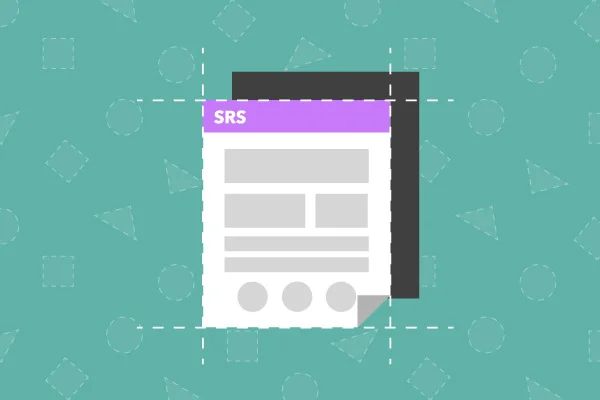
How to Write a Software Requirements Specification (SRS Document)
Clear, concise, and executable requirements help development teams build high quality products that do what they are supposed to do. The best way to create, organize, and share requirements is a Software Requirements Specification (SRS). But what is an SRS, and how do you write one?
In this blog, we'll explain what a software requirements specification is and outline how to create an SRS document, including how to define your product's purpose, describe what you're building, detail the requirements, and, finally, deliver it for approval. We'll also discuss the benefits of using a dedicated requirements management tool to create your SRS vs. using Microsoft Word.
Continue reading or jump to the section that interests you most:
What Is a Software Requirements Specification (SRS) Document?
A software requirements specification (SRS) is a document that describes what the software will do and how it will be expected to perform. It also describes the functionality the product needs to fulfill the needs of all stakeholders (business, users).
You can think of an SRS as a blueprint or roadmap for the software you're going to build. The elements that comprise an SRS can be simply summarized into four Ds:
- Define your product's purpose.
- Describe what you're building.
- Detail the requirements.
- Deliver it for approval.
We want to DEFINE the purpose of our product, DESCRIBE what we are building, DETAIL the individual requirements, and DELIVER it for approval. A good SRS document will define everything from how software will interact when embedded in hardware to the expectations when connected to other software. An even better SRS document also accounts for the needs of real-life users and human interaction.
Why Use an SRS Document?
An SRS gives you a complete picture of your entire project. It provides a single source of truth that every team involved in development will follow. It is your plan of action and keeps all your teams — from development and testing to maintenance — on the same page.
An SRS not only keeps your teams aligned and working toward a common vision of the product, it also helps ensure that each requirement is met. It can ultimately help you make vital decisions on your product’s lifecycle, such as when to retire an obsolete feature.
It takes time and careful consideration to create a proper SRS. But the effort it takes to write an SRS is gained back in the development phase. It helps your team better understand your product, the business needs it serves, its users, and the time it will take to complete.
Software Requirements Specification vs. System Requirements Specification
What is the difference between a software requirements specification document and a system requirements specification document?
“Software” and “system” are sometimes used interchangeably as SRS. But, a software requirements specification provides greater detail than a system requirements specification.
A system requirements specification (abbreviated as SyRS to differentiate from SRS) presents general information on the requirements of a system, which may include both hardware and software, based on an analysis of business needs.
A software requirements specification (SRS) details the specific requirements of the software that is to be developed.
Need to prove compliance? Here's how to create a traceability matrix >>
Back to topHow to Write an SRS Document
Creating a clear and effective SRS document can be difficult and time-consuming. But it is critical to the efficient development of a high quality product that meets the needs of business users.
Here are five steps you can follow to write an effective SRS document.
1. Define the Purpose With an Outline (Or Use an SRS Template)
Your first step is to create an outline for your software requirements specification. This may be something you create yourself, or you can use an existing SRS template.
If you’re creating the outline yourself, here’s what it might look like:
1. Introduction
1.1 Purpose
1.2 Intended Audience
1.3 Intended Use
1.4 Product Scope
1.5 Definitions and Acronyms
2. Overall Description
2.1 User Needs
2.2 Assumptions and Dependencies
3. System Features and Requirements
3.1 Functional Requirements
3.2 External Interface Requirements
3.3 System Features
3.4 Nonfunctional Requirements
This is a basic outline and yours may contain more (or fewer) items. Now that you have an outline, lets fill in the blanks.
Download a white paper on best practices for writing requirements >>
2. Define your Product’s Purpose
This introduction is very important as it sets expectations that we will come back to throughout the SRS.
Some items to keep in mind when defining this purpose include:
Intended Audience and Intended Use
Define who in your organization will have access to the SRS and how they should use it. This may include developers, testers, and project managers. It could also include stakeholders in other departments, including leadership teams, sales, and marketing. Defining this now will lead to less work in the future.
Product Scope
What are the benefits, objectives, and goals we intend to have for this product? This should relate to overall business goals, especially if teams outside of development will have access to the SRS.
Definitions and Acronyms
Clearly define all key terms, acronyms, and abbreviations used in the SRS. This will help eliminate any ambiguity and ensure that all parties can easily understand the document.
If your project contains a large quantity of industry-specific or ambiguous terminology or acronyms, you may want to consider including a reference to a project glossary, to be appended to the SRS, in this section.
>> Need to create a PRD? Here's a how-to with examples >>
3. Describe What You Will Build
Your next step is to give a description of what you’re going to build. Why is this product needed? Who is it for? Is it a new product? Is it an add-on to a product you’ve already created? Is this going to integrate with another product?
Understanding and getting your team aligned on the answers to these questions on the front end makes creating the product much easier and more efficient for everyone involved.
User Needs
Describe who will use the product and how. Understanding the various users of the product and their needs is a critical part of the SRS writing process.
Who will be using the product? Are they a primary or secondary user? What is their role within their organization? What need does the product need to fulfill for them?
Do you need to know about the purchaser of the product as well as the end user? For the development of medical devices and med device software, you may also need to know the needs of the patient.
Assumptions and Dependencies
What are we assuming will be true? Understating and laying out these assumptions ahead of time will help with headaches later. Are we assuming current technology? Are we basing this on a Windows framework? We need to take stock of these technical assumptions to better understand where our product might fail or not operate perfectly.
Finally, you should note if your project is dependent on any external factors. Are we reusing a bit of software from a previous project? This new project would then depend on that operating correctly and should be included.
4. Detail Your Specific Requirements
In order for your development team to meet the requirements properly, we must include as much detail as possible. This can feel overwhelming but becomes easier as you break down your requirements into categories. Some common categories are functional requirements, interface requirements, system features, and various types of nonfunctional requirements:
Functional Requirements
Functional requirements are essential to your product because, as the name implies, they provide some sort of functionality.
Asking yourself questions such as “does this add to my tool’s functionality?” or “what function does this provide?” can help with this process. Within medical devices especially, these functional requirements may have a subset of domain-specific requirements.
You may also have requirements that outline how your software will interact with other tools, which brings us to external interface requirements.
External Interface Requirements
External interface requirements are specific types of functional requirements. These are especially important when working with embedded systems. They outline how your product will interface with other components.
There are several types of interfaces you may have requirements for, including:
- User
- Hardware
- Software
- Communications
System Features
System features are a type of functional requirements. These are features that are required in order for a system to function.
Nonfunctional Requirements
Nonfunctional requirements, which help ensure that a product will work the way users and other stakeholders expect it to, can be just as important as functional ones.
These may include:
- Performance requirements
- Safety requirements
- Security requirements
- Usability requirements
- Scalability requirements
The importance of each of these types of nonfunctional requirements may vary depending on your industry. In industries such as medical device, life sciences, and automotive, there are often regulations that require the tracking and accounting of safety.
IEEE provides guidance for writing software requirements specifications, if you’re a member.
9 tips for writing better requirements >>
5. Deliver for Approval
We made it! After completing the SRS, you’ll need to get it approved by key stakeholders. This will require everyone to review the latest version of the document.
Back to top
Writing an SRS in Microsoft Word vs. Requirement Software
You can write your software requirement specification in Microsoft Word. A smart way to do this is to create an SRS template that you can use as a starting point for every project.
However, even with a template, writing an SRS this way can be a painstaking process. And if a requirement changes, your SRS can quickly fall out-of-date. Plus, there can be versioning issues with requirements documents that are written in Word.
Why is this an issue? Well, if you discover too late that your engineering teams have been working from an older version of your requirements, you may end up needing a lot of rework to re-align the product with the current requirements. And that rework result in waste of resources and development delays.
You can save time — and ensure product quality — by writing and maintaining your SRS in a dedicated requirements management tool like Helix ALM instead.
Back to topWhy Helix ALM Is the Best Tool for SRS
Helix ALM, a unified requirement and test management platform, can streamline and simplify the creation of your SRS. What's more, it will improve visibility, alignment, and efficiency throughout your entire requirements management process.
By creating your SRS in Helix ALM, you’ll ensure a single source of truth for your SRS— no more wondering if everyone is looking at the latest version. It will be easier to do requirements reviews of your SRS. And that will help you get faster approvals — so your developers can get started.
If you’re also writing a PRD, you can link those feature requirements to the high-level requirement in the SRS. This will ensure alignment across all types of requirements.
Once you've created your SRS in Helix ALM, you can easily manage requirements and changes throughout the product lifecycle. And you can rest assured that teams across your organization are working from the most up-to-date version of your requirements.
In Helix ALM, you can even link your requirements to test cases, and trace test results back to requirements, for end-to-end traceability across the development process. This helps ensure that the product you deliver fulfills the purpose and requirements set forth in your SRS. And for organizations in heavily regulated industries, this traceability helps you prove compliance and makes it easier to pass audits.
See for yourself how easy it can be to write an SRS. Try Helix ALM free — and see how an effective SRS will improve your development process. You can also watch our demo to see more of Helix ALM's requirement management capabilities.
save time writing an SRS in Helix ALM ▶️ watch the demo First
Editor's Note: This blog was first published in October 2018 and was updated for quality and accuracy in January 2023.
Back to top
